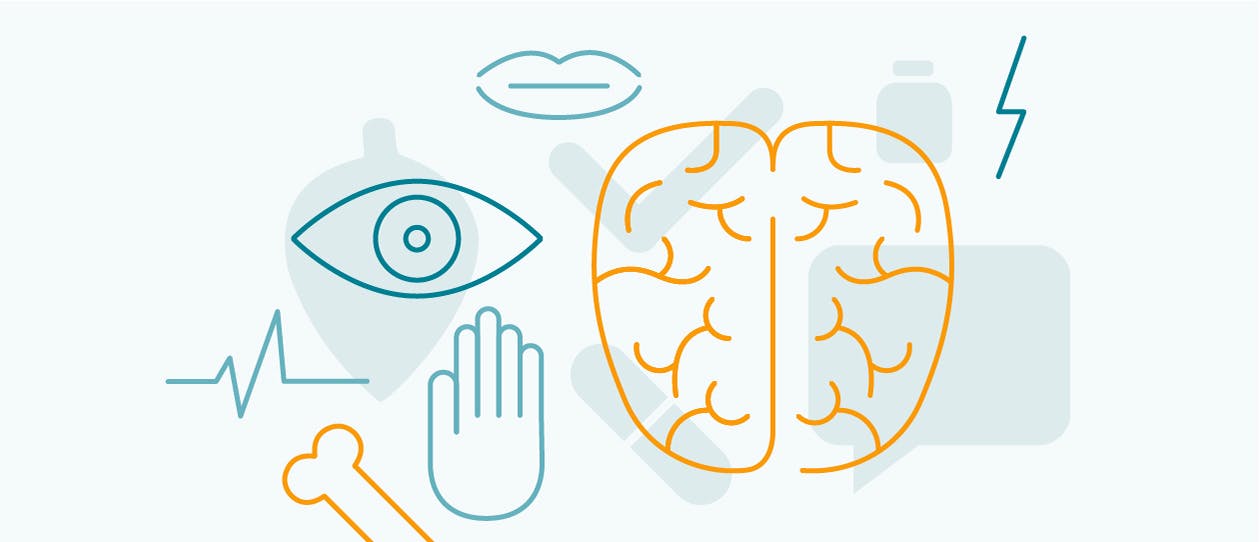
- Health hub/
- Arthritis, joint, bone & muscle/
- Pinched nerve


The symptoms of a pinched or entrapped nerve depend on the location and function of the affected nerve. Pain, numbness and irritation in the part of the body served by the nerve are common symptoms, and weakness and wasting of the muscles may also occur if the condition is longstanding.
Over the long term, the skin may become thin, dry and susceptible to ulcers, and nails may become ridged and cracked.
Common examples of pinched nerve syndromes and their symptoms include:
Carpal tunnel syndrome:
- Pain is described as burning, tingling or like an electric shock or pins and needles. The pain may travel from the wrist up the arm or down into the palm and fingers, but the little finger and half the ring finger usually remain unaffected. Pain may also be referred into the arm and shoulder. The pain may be worse at night, and may wake the patient up.
- Numbness in the palm, wrist, fingers or forearm. This is often the first symptom and may occur when driving or holding something, such as a mobile phone.
- Weakness of the hand and reduced ability to use the thumb may develop as the condition progresses, limiting the ability to hold objects and interfering with every day activities such as buttoning clothes or tying laces. The muscles may become visibly wasted (reduced in size).
Cubital tunnel syndrome:
- Pain is described as aching, and is felt deep within the elbow region. It tends to feel worse when the inner side of the elbow is knocked or pressed.
- Pain may be worse at night, especially if you sleep with your elbow bent.
- Intermittent tingling and numbness in the ring and little fingers may occur.
- It may become difficult to grasp objects as the hand may become weak. Wasting of the hand muscles may occur over time.
Sciatica:
- Aching or hot pain in the buttock, hamstring (back of the thigh), calf, ankle and/or foot, which may be aggravated when coughing or straining (e.g. lifting heavy objects).
- Pins and needles may also occur.
- Muscles of the leg and foot may become weak.
Pinched nerves can also occur in other parts of the body, including the shoulder and groin.
Pinched nerves tend to occur at places where a nerve travels through a ‘tunnel’ of ligaments and bony surfaces, and the wrist (carpal tunnel syndrome, caused by compression of the median nerve) and elbow (cubital tunnel syndrome, caused by compression of the ulnar nerve) are the most common locations for these injuries to occur.
Both carpal and cubital tunnel syndromes may be caused by any of a number of factors that reduce the space inside the tunnels that house the nerves. These include:
- Trauma or injury to the wrist or elbow.
- Over-use of the hands or elbows (for example, participating in work or sporting activities that involve long periods of repetitive movements, such as computer work, assembly line work, construction work, gardening or golfing). In the case of cubital tunnel syndrome, resting the elbow on a hard surface for long periods of time may also contribute.
- Fluid retention (for example, as a consequence of pregnancy).
- Inflammation of the tissues (for example due to rheumatoid arthritis).
Deficiency of vitamin B6 may also be associated with carpal tunnel syndrome.
The sciatic nerve travels from the spinal cord, into the buttock and then down the thigh and leg. Sciatica occurs if a disc between the vertebrae bulges out, causing pressure on the sciatic nerve. This is often referred to as a ‘slipped disc’.
Osteoarthritis may also cause sciatic pain by narrowing the space available for the nerve to travel through. Accordingly, sciatica becomes more prevalent as we get older and the bony and cartilaginous structures of the spine degenerate.
- In many cases, changes to your lifestyle may help resolve the symptoms, but it is still advisable to seek professional treatment, as pinched nerves that are severe or persist for a long time can potentially lead to permanent damage to the tissues. The following suggestions are recommended as supportive measures, and should not take the place of professional care and advice.
- Immobilisation can be very useful in some cases. For example, splinting of the wrist is commonly used to minimise movement and decrease pressure on the nerve in carpal tunnel syndrome, and more than 80% of patients report that this leads to an improvement in symptoms. Don’t delay in asking your physiotherapist whether this is an appropriate option for you, as splinting appears to be most beneficial when commenced within 3 months of the development of symptoms.
- However, while immobilisation (bed rest) was previously recommended for relief of sciatica, remaining active is now considered more effective. After consultation with your doctor or physiotherapist, exercise regularly, choosing gentle, low-impact activities such as swimming.
- Your healthcare professional can assist with information about behaviour and particular movements to avoid, and specific exercises to stretch, strengthen and condition the tissues in the affected area, which may help to relieve your symptoms.
- If you do repetitive work and suffer from carpal tunnel syndrome; avoid bending the wrist excessively when working on a computer keyboard, or putting the wrists into any positions that worsen your symptoms.
- If you have sciatica, avoid bending over or lifting heavy weights.
- Ask your physiotherapist about ergonomic aids that may be beneficial for your circumstances. For example, some computer operators find that ergonomically designed keyboards decrease the pressure on the wrists, and ergonomic furniture (e.g. chairs with lumbar support) may be beneficial for some patients with sciatica.
- Stop smoking, as it may delay your recovery.
- If you have an underlying health problem that predisposes you to nerve entrapment (for example, hypothyroidism or rheumatoid arthritis), working with your healthcare professional to manage your condition may help to reduce your nerve symptoms at the same time.
- Women whose symptoms have arisen due to pregnancy can expect to find relief after the baby’s born, and people who are obese are likely to notice symptom relief when they lose weight.
- In addition to physiotherapy, treatment from a chiropractor, osteopath, or acupuncturist may help.
Try to avoid the tasks that aggravate the condition.
- Consult your healthcare professional if you have a pinched nerve, especially if the symptoms are severe or limit your movement.
- Surgery may be recommended if symptoms don’t improve with other measures, or are severe or long standing.




